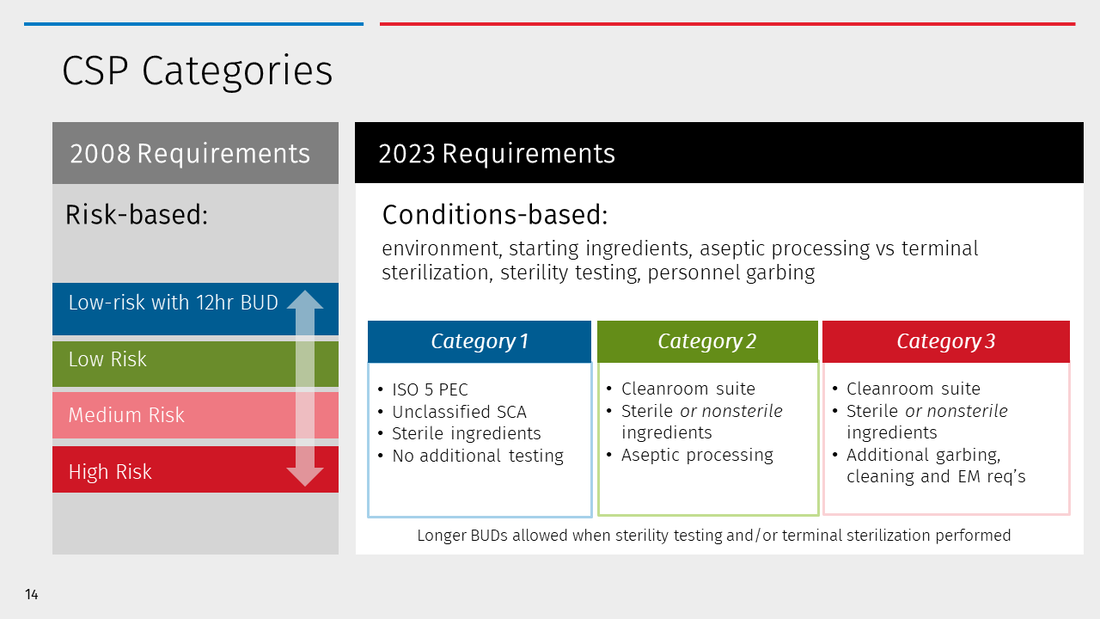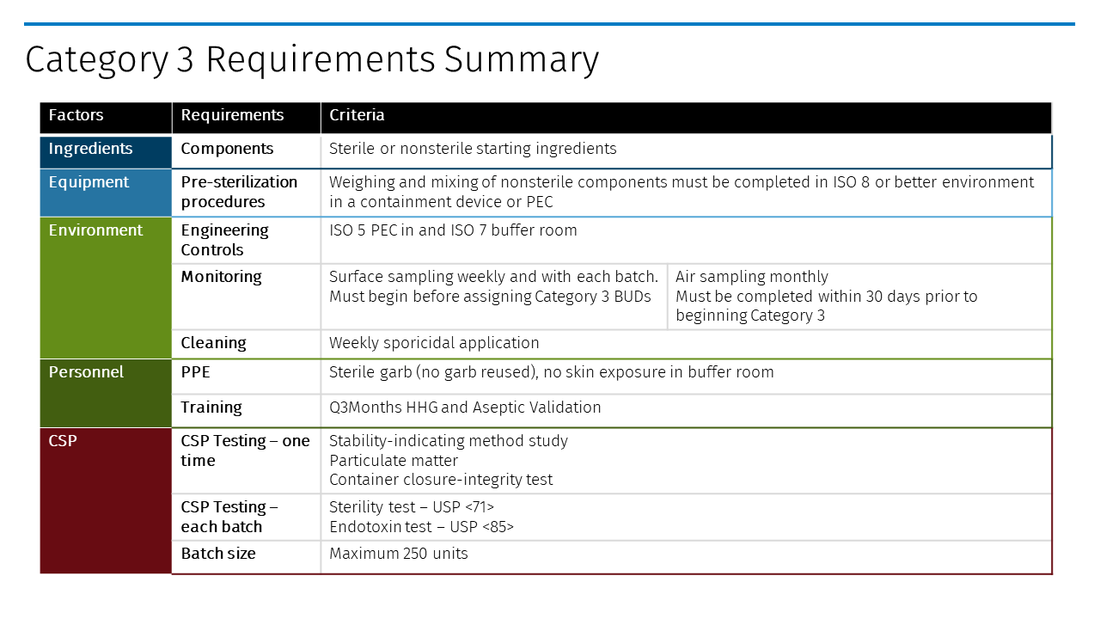USP Chapter <797> categorizes risk levels based on the likelihood of contamination of a compounded sterile preparation (CSP).
Contamination can come from a variety of sources. Per USP <797> Section 1.5 CSP Categories: This chapter distinguishes three categories of CSPs: Category 1, Category 2, and Category 3, primarily based on the state of the environmental control under which they are compounded, the probability for microbial growth during the time they will be stored, and the time period within which they must be used. Understanding this rationale is key to categorizing the risks to CSPs prepared in your organization.
These concepts and definitions expand on the risk-level-based beyond-use dates (BUDs) from the 2008 version of the Chapter. Here's a quick guide comparing some of the key considerations when evaluating risk levels to CSPs in your organization.
General principles of compounding risk level
In USP <797> (2008), the risk level is defined primarily by the complexity of the compounding process. Fewer components for a mixture or a lower level of product manipulation indicated low-risk conditions. Combining three or more ingredients or packages, multiple additive injections, or non-sterile ingredients indicated medium to high-risk. The higher the risk level, the greater risk for contamination or lack of sterility, leading to increased risk for patient harm. These concepts are still important but are no longer the only determination for compounding risk level and subsequent BUDs.
USP <797> (2023) considers additional factors that may introduce risk to the final CSP. These focus primarily on the environment in which the compound is prepared. Examples include air quality and facility design, as well as the frequency of monitoring the environment. Additionally, the sterility of starting ingredients or methods for sterilizing final CSPs must be considered. All these factors increase the risk of microbial contamination in the final CSP. The more controls are put into place, the lower risk and thus longer BUD.
Category 3 CSPs represent the highest risk starting components, requiring more frequent environmental monitoring and personnel competency validation, and the use of sterile personal protective equipment (PPE). Yet those preparing Category 3 CSPs will be rewarded with the longest BUDs allowed in the Chapter.
Refer to Table 1 for a comparative summary of current risk levels and new categories for CSPs.
Operational implications of new CSP Categories
Determining CSPs Categories is important because it establishes the beyond-use date (BUD) for each CSP. The BUD is the date and time by which administration of a CSP must begin. In other words, the safe storage limit ensures reasonable sterility of a CSP under certain conditions – without performing a sterility test.
Compound Sterile Preparation Categories
Category 1 CSPs
Category 1 CSPs are prepared in an ISO 5 Primary Engineering Control (PEC) but in an otherwise uncontrolled or unclassified space e.g., a Segregated Compounding Areas (SCA). BUDs are limited to 12 hours at room temperature and 24 hours refrigerated, or less per product stability.
Category 1 BUDs apply when a CSP is prepared under less-than-ideal circumstances, including environmental or procedural conditions, that increase the risk of microbial contamination. Examples include:
- A segregated compounding area (SCA) with inadequate filtration, air pressure, or air exchanges to meet ISO 7 classification criteria.
- Temporary break in the state of control of a classified buffer area, such as power failure resulting in loss of pressure.
Other notable considerations when evaluating the impacts of old risk levels and new categories:
Hazardous Drugs
Per USP <797> (2008), only non-hazardous and radiopharmaceutical CSPs may be prepared in an (SCA) under low-risk with 12-hour BUD conditions. Under the new USP <797> (2023), no limitations on the type of CSPs are mentioned and USP <800> will become compendial applicable. USP <800> describes the criteria for Containment-Segregated Compounding Areas (C-SCAs) that allow for compounding of hazardous drugs with 12-hour (room temp), 24-hour (refrigerated), or less BUD. Minimally, C-SCAs must have:
- At least 12 air changes per hour (ACPH)
- Maintain negative pressure of -0.01 to -0.03 i.w.c. for the room, with an externally vented containment primary engineering control (C-PEC).
Restricted-access barrier systems (RABS)
Examples include Compounding Aseptic Isolators (CAI) and Compounding Aseptic Containment Isolators (CACI) provide an ISO 5 compounding environment. However, if these types of PECs are placed in an SCA, only Category 1 BUDs may be applied. Many organizations have relied on RABS to serve as the sole source of classified air and have completed higher risk level compounding or even anticipatory compounding without additional environmental controls. This is no longer allowed under the new standards. If your facility has a CAI or CACI in an SCA, assess the type of compounding performed and the impacts of decreasing BUDs to a max of 24 hours (refrigerated).
Category 2 CSPs
Category 2 CSPs require a higher level of environmental control including preparation in an ISO 5 PEC and a classified cleanroom suite. Refer to the Chapter for the full criteria of a cleanroom suite including air flow, temperature, humidity, pressure, and design requirements. Most pharmacies with a modern cleanroom design should have the type of environment to support Category 2 BUDs.
BUDs for Category 2 CSPs are determined by the environment as well as the sterility of the starting ingredients and what type of sterilization techniques are used. Examples when prepared in an ISO 5 PEC and a full cleanroom suite:
- Typical or most common scenario: Sterile starting ingredients aseptically prepared with no additional sterility testing results in BUDs of 4 days (room temp), 10 days (refrigerated), 45 days (frozen)
- Maximum BUDs scenario: Terminally sterilized CSPs prepared with additional sterility testing performed and passed results in BUDs of 45 days (room temp), 60 days (refrigerated), and 90 days (frozen).
Category 2 CSPs may be prepared from non-sterile starting ingredients. Longer BUDs are available if sterility testing is performed and passed, with no additional facility monitoring or personnel competency assessments required.
Category 3 CSPs
Multiple factors increase the risk of contamination when preparing Category 3 CSPs. These include the use of non-sterile starting ingredients or non-sterile devices which are inherently at risk of microbial contamination, as well as longer storage time which increases risk due to stability issues, compromise of the container closure system, and microbial proliferation. The greatest level of control is required to mitigate these risks.
Category 3 requirements are summarized in Table 2. Refer to section 14.4 of USP <797> for a full list of expectations. After implementing all the criteria, CSPs are allowed the longest BUDs in the Chapter up to a maximum of 90 days (room temp.), 120 days (refrigerated), and 180 days (frozen). Refer to Table 14: BUD Limits for Category 3 CSPs for all preparation characteristics. Also note that Category 3 requirements must be met at least 30 days prior to beginning Category 3 compounding and all elements must be maintained even if only completing occasional compounding of this type.
The investment in sterile garb, more frequent competency testing, more frequent environmental monitoring, and sterilization processes is significant. If considering adapting current high-risk compounding processes to meet new Category 3 standards, you should assess the need for extended BUDs among your patient population as well as the workflow impacts if shorter BUDs are used. Be sure to assess the return on this investment and the long-term maintenance of a Category 3 compounding program.
While the terminology may be different in the new USP <797> (2023), it remains important to understand all the factors that contribute to the risks of compounding. The more complex the procedure, the lower state of control of the environment, or the longer the BUD, the risk of contamination increases. Ultimately, establishing CSP Categories does include assessing risk – the risk of microbial contamination which is a real concern for protecting patients from harm.
Need more help getting ready for the new USP <797> standards? Watch our CE webinar USP <797>: Understanding Final Chapter Requirements and How to Start Implementation



